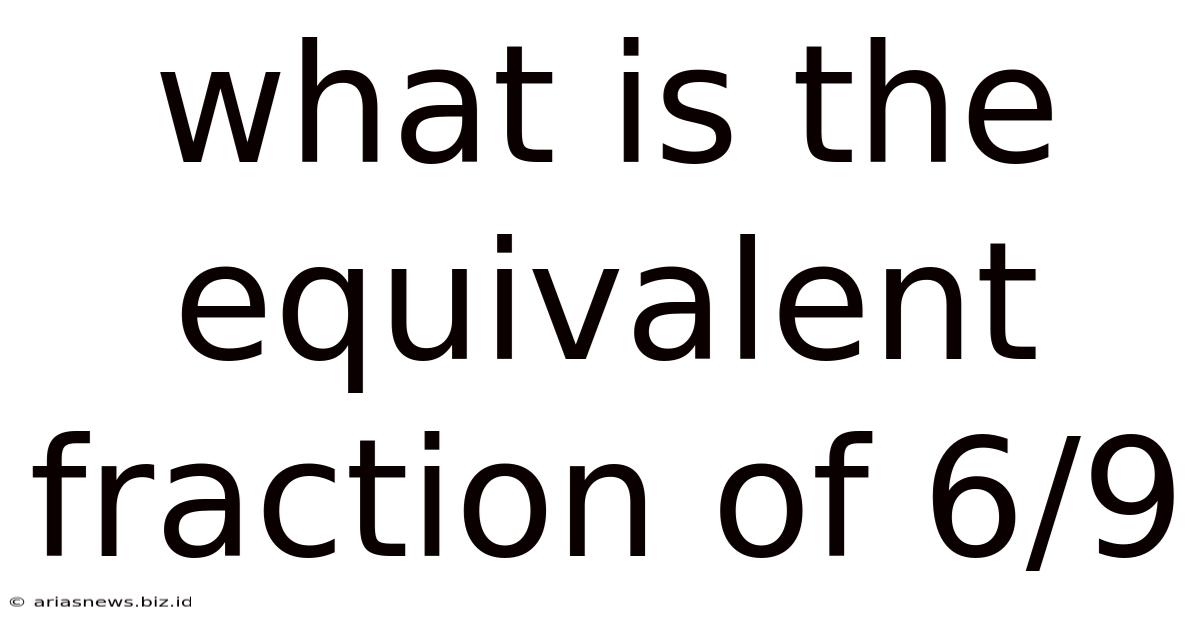What Is The Equivalent Fraction Of 6/9
Arias News
May 11, 2025 · 4 min read

Table of Contents
What is the Equivalent Fraction of 6/9? A Comprehensive Guide
Finding equivalent fractions is a fundamental concept in mathematics, crucial for understanding proportions, simplifying expressions, and solving various problems. This comprehensive guide delves deep into the concept of equivalent fractions, focusing specifically on finding the equivalent fractions of 6/9. We'll explore different methods, provide numerous examples, and discuss the underlying mathematical principles. By the end, you'll not only know the equivalent fractions of 6/9 but also possess a solid understanding of the broader concept.
Understanding Equivalent Fractions
Equivalent fractions represent the same portion or value, even though they appear different. Imagine slicing a pizza: one-half (1/2) is the same as two-quarters (2/4), or four-eighths (4/8). These are all equivalent fractions. The key is that the ratio between the numerator (the top number) and the denominator (the bottom number) remains constant.
The Fundamental Principle: To create an equivalent fraction, you multiply or divide both the numerator and the denominator by the same non-zero number. This is crucial; you must perform the identical operation on both parts of the fraction to maintain the original ratio.
Finding Equivalent Fractions of 6/9: Methods and Examples
Let's now focus on finding the equivalent fractions of 6/9. We'll explore several methods, illustrating each with clear examples.
Method 1: Simplifying by Finding the Greatest Common Divisor (GCD)
This is arguably the most common and efficient method. It involves finding the greatest common divisor (GCD) of the numerator (6) and the denominator (9). The GCD is the largest number that divides both numbers without leaving a remainder.
The GCD of 6 and 9 is 3. We then divide both the numerator and the denominator by the GCD:
6 ÷ 3 = 2 9 ÷ 3 = 3
Therefore, the simplest equivalent fraction of 6/9 is 2/3. This is often referred to as the fraction in its simplest form or lowest terms.
Example: Let's verify that 2/3 and 6/9 represent the same value. We can convert both fractions to decimals:
2/3 ≈ 0.6667 6/9 ≈ 0.6667
Both fractions are approximately equal to 0.6667, demonstrating their equivalence.
Method 2: Multiplying the Numerator and Denominator by the Same Number
This method involves multiplying both the numerator and the denominator by the same non-zero integer. This generates an infinite number of equivalent fractions.
Example 1: Multiply both the numerator and denominator of 6/9 by 2:
(6 × 2) / (9 × 2) = 12/18
Therefore, 12/18 is an equivalent fraction of 6/9.
Example 2: Multiply both the numerator and denominator of 6/9 by 5:
(6 × 5) / (9 × 5) = 30/45
Therefore, 30/45 is another equivalent fraction of 6/9.
You can continue this process indefinitely, multiplying by any integer to generate countless equivalent fractions.
Method 3: Using Visual Representations
Visual aids can significantly improve understanding. Imagine a rectangle divided into 9 equal parts, with 6 of them shaded. This visually represents 6/9. Now, imagine grouping those 9 parts into larger sections. For instance, you could group them into three larger sections, with two shaded. This visual representation corresponds to the simplified fraction 2/3. This approach is particularly helpful for beginners.
Why Finding Equivalent Fractions is Important
The ability to identify and manipulate equivalent fractions is essential for numerous mathematical concepts and applications:
- Simplifying Fractions: Reducing fractions to their simplest form improves readability and makes calculations easier.
- Comparing Fractions: To compare fractions with different denominators, you often need to find equivalent fractions with a common denominator.
- Adding and Subtracting Fractions: This requires finding equivalent fractions with a common denominator before performing the operations.
- Solving Proportions: Many real-world problems involve proportions, which rely heavily on understanding equivalent fractions.
- Understanding Ratios: Equivalent fractions directly represent equivalent ratios.
- Working with Percentages: Percentages are essentially fractions with a denominator of 100; understanding equivalent fractions helps in converting between fractions and percentages.
Beyond 6/9: A Broader Perspective
The principles discussed for finding equivalent fractions of 6/9 apply universally. You can use the same methods – finding the GCD, multiplying by a common factor, or visual representation – to find equivalent fractions for any given fraction.
Example: Let's find some equivalent fractions for 3/4:
- Simplifying: 3/4 is already in its simplest form, as 3 and 4 have no common divisors other than 1.
- Multiplying:
- (3 × 2) / (4 × 2) = 6/8
- (3 × 3) / (4 × 3) = 9/12
- (3 × 4) / (4 × 4) = 12/16
All of 6/8, 9/12, and 12/16 are equivalent to 3/4.
Conclusion: Mastering Equivalent Fractions
Mastering equivalent fractions is fundamental to success in mathematics. This guide has comprehensively explored the concept, focusing specifically on 6/9, but the methods are universally applicable. Remember the core principle: maintain the ratio by performing the same operation on both the numerator and denominator. By practicing these techniques and understanding the underlying principles, you'll confidently navigate the world of fractions and their numerous applications. Continue practicing, and you'll quickly develop proficiency in finding and working with equivalent fractions. This foundational skill will undoubtedly serve you well in your mathematical journey.
Latest Posts
Latest Posts
-
What Are The Tiny Holes In Leaves Called
May 11, 2025
-
Was John The Baptist Older Than Jesus
May 11, 2025
-
Examples Of Potential Energy In Your Home
May 11, 2025
-
What Is 35 2 Degrees Celsius In Fahrenheit
May 11, 2025
-
How Old Are You If You Are Born In 1969
May 11, 2025
Related Post
Thank you for visiting our website which covers about What Is The Equivalent Fraction Of 6/9 . We hope the information provided has been useful to you. Feel free to contact us if you have any questions or need further assistance. See you next time and don't miss to bookmark.